Table of Contents

Main Important Affirmations to Adopt During Meditation
- There is no wrong way to meditate
- There is nothing wrong with getting distracted, and there is no reason to feel guilt for it
- Any discomfort that arises is inherently okay. I will listen to myself and pay attention to what my needs are. If I need to readjust or take a break, I am free to do so. Simply sitting and acknowledging my thoughts and feelings is also a good idea.
- I am willing to try new things that may work better for me. If the last meditation was very difficult, maybe I can try something new, (like a counting technique seen online, or a different guided meditation)
- Choosing to meditate is an act of self love.
What Is Meditation?
In this video “Meditation and Going Beyond Mindfulness – A Secular Perspective” by Yongey Mingyur Rinpoche, He talks about what meditation is and how we look at it. He also does a guided meditation that can be very helpful for any beginners.
One of the main takeaways from this video is the concept of meditation through awareness.
At all times, you have awareness. The “secret” to meditation as Rinpoche reveals, is that we simply need to connect with and recognize our awareness.
He relates awareness to space. It is always there, but sometimes we cannot see it because it is blocked by clouds (aka emotions and overthinking).
So really the only thing you need to do to meditate, is just take a step back and be present as best you can.
Myths & Misconceptions About Meditation
- You need to have total silence
- You need to be sitting on the floor with your eyes closed
- You must keep perfectly still
- There is a right way to meditate
- If I do not feel good, calm, and “enlightened”, I must be doing something wrong
First of all, the ultimate goal of meditation is not to reach enlightenment or experience ego death or having the ability to brag about how you meditate.
The ultimate goal of meditation is simply to give yourself time to listen. Listen to your feelings, your surroundings, your body. Letting yourself observe and acknowledge each passing thought that may arise.
The peace comes from the practice of shifting the awareness back to your senses, and resting your judgements on anything and everything. It is learning acceptance, slowly but surely.
The stereotypical ideas of meditation can work perfect for one person, but to another it can feel like complete torture. Like your whole body is itchy but you aren’t allowed to scratch it or put on cooling ointment.
If someone has a hard time using the vacuum because of the loud noise, it is better for them to find ways to help, such as noise suppressing headphones, rather than give up on cleaning entirely.
The same applies to meditation. In the era of constant entertainment and stimulation, taking even one minute to focus on something that calms you and quiets the mind can be ridiculously beneficial.
Common Struggles
Needing to move or stim
This is natural especially if you are neurodivergent in any way. Perhaps you can adopt a motion that connects you with your sense of physical touch. Some people have a piece of fabric to feel. Or you could try touching your fingers to your thumbs and concentrate on the sensation you feel.
If your movement produces a sound, try to focus on that sound. Really allow whatever you are doing to further ground you and keep you present.
There is also no rule against rocking back and forth a bit! If it makes you feel at ease and comfortable, a gentle and relaxing stim/ movement can make meditation even better.
Having trouble keeping your mind from wandering
Don’t think of an elephant!!!
As humans, we like to think. A lot. This is a beautiful thing, but it can also be incredibly overwhelming.
When meditating, our minds are bound to trail off a bit at some point. If you catch yourself thinking about random things, refrain from scolding yourself over it. You did nothing wrong and getting distracted is normal.
All you need to do is gently try to shift your focus back on your senses or other meditation technique. If you are listening to a guided meditation, just tune back in.
Try not to get too frustrated with yourself. This is a relaxing experience, not a test.
Over or under stimulation
Too quiet? Not quiet enough?
If this is a struggle for you, try to remember that the point is to release judgment on the world around you and simply accept and acknowledge it. It may be frustrating at first, but see how many sounds you can tune into. If it is incredibly silent, focus on the sound your breath
If you are in a situation where it is too loud and distracting, it is a bit more difficult to deal with if you can’t simply go somewhere else.
If you have a pair of headphones, turn on some white noise to help tune out the other sounds.
Do your best to listen to any surrounding noises without judgment, and try to find the beauty in them.

Grounding Techniques & Shifting Your Awareness to Your Senses
Here are some examples:
Have a piece of fabric or an item with texture you can feel and focus on.
Light a candle and focus on the scent, or find another smell you enjoy. Feel free to relive happy memories associated with this smell if you have any.
Closing your eyes helps elevate your other senses and can be helpful for focusing on your breath. However, if you don’t want to keep your eyes closed, you can rest your eyes gently on something beautiful and calming. This could be the flame of a candle in a dimly lit room, or a leaf fluttering in the breeze.
How to Actually Start Meditating
If you have ADHD or a similar condition that makes it difficult for you to shift focus onto a new task or activity, here are some tips for you.
- Body doubling
See if you have a friend or family member that would be interested in taking up meditation with you.
You could have them in the same room with you, or perhaps on a call where you listen to the same guided meditation.
- Turn step one into your only task, bonus points for a routine!
Maybe in order to meditate you like the classic criss cross applesauce on a yoga mat. If you are feeling overwhelmed make the goal to simply roll out the yoga mat. This will also serve as a helpful reminder that you had plans to meditate in case you get distracted.
Other examples of this could be lighting a candle, turning on meditation music, or setting a 5 minute timer for a phone break.
Remember: even if you do not immediately follow through with the meditation, completing that task is a success.
- Have a “meditation station” ready to go
Whether you have a whole relaxing room or just a comfy spot by your bed, having a visible area to meditate makes a big difference.
Have a place for meditation that looks too lovely to resist a quick meditation sesh (or a nap if you really need it).
Make sure this place feels safe for you, and make sure you will be able to see it regularly. This place should also be easy to access. Don’t put it in a cold shed across a backyard or the attic you never go to.
Conclusion
Meditation is a beautiful worthwhile act of self care. It is a flexible practice that can be adjusted to suit anyone’s needs.
Meditation is also essential for having a peaceful mindset. Any form of giving your mind time to pause and rest is incredibly helpful!
If you have struggled with meditation, take this as an opportunity to experiment with the best way for YOU to go about it.







